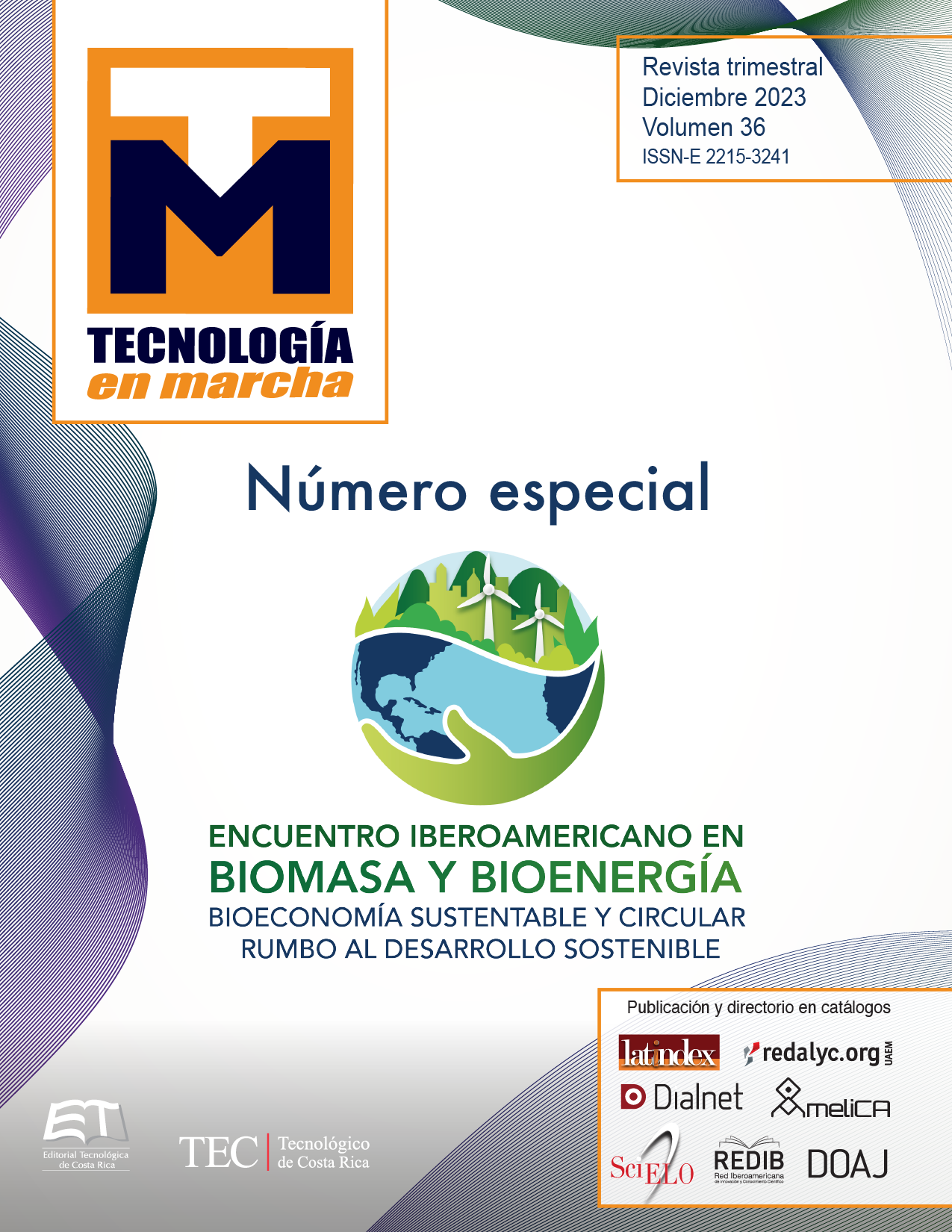Integración energética de una biorefinería de Jatropha curcas para la producción de bioturbosina
Contenido principal del artículo
Resumen
El desarrollo de procesos para la producción de combustible renovable de aviación coadyuva a la recuperación sostenible del sector de aviación; en tales procesos, la aplicación de estrategias de eficiencia energética puede mejorar su competitividad económica y ambiental. En este trabajo se presenta la integración energética en una biorefinería de Jatropha curcas (JC) para la producción de bioturbosina, como producto principal, mediante la metodología del punto de pliegue. La aplicación de la integración energética se basa en la construcción de dos rutas, definidas por los intercambios de material entre los procesos que las integran. En la ruta 1 (R1) se consideran 7 y 6 corrientes calientes y frías, respectivamente; mientras que para la ruta 2 (R2), 6 y 8 corrientes calientes y frías, respectivamente. Los resultados muestran que es posible ahorrar hasta 82,41 % y 74,89 % de servicios de calentamiento y enfriamiento para R1, mientras que hasta 71 % y 87,28 % de ahorro de servicios de calentamiento y enfriamiento para R2. Estos resultados suponen menor impacto ambiental, respecto al esquema sin integración, debido al menor consumo de servicios externos, lo cual podría mejorar significativamente la economía del proceso.
Detalles del artículo

Esta obra está bajo una licencia internacional Creative Commons Atribución-NoComercial-SinDerivadas 4.0.
Los autores conservan los derechos de autor y ceden a la revista el derecho de la primera publicación y pueda editarlo, reproducirlo, distribuirlo, exhibirlo y comunicarlo en el país y en el extranjero mediante medios impresos y electrónicos. Asimismo, asumen el compromiso sobre cualquier litigio o reclamación relacionada con derechos de propiedad intelectual, exonerando de responsabilidad a la Editorial Tecnológica de Costa Rica. Además, se establece que los autores pueden realizar otros acuerdos contractuales independientes y adicionales para la distribución no exclusiva de la versión del artículo publicado en esta revista (p. ej., incluirlo en un repositorio institucional o publicarlo en un libro) siempre que indiquen claramente que el trabajo se publicó por primera vez en esta revista.
Citas
IEA, “IEA – COVID-19 Topics,” International Energy Agency, 2021. [Online]. Available: https://www.iea.org/topics/covid-19. [Accessed: 01-Sep-2022].
I. E. A. IEA, “World Energy Outlook 2020 – Analysis - IEA,” 2020. [Online]. Available: https://www.iea.org/reports/world-energy-outlook-2020#executive-summary. [Accessed: 24-Jun-2021].
International Air Transport Association (IATA), “IATA - Post-COVID-19 Green Recovery Must Embrace Sustainable Aviation Fuels,” 2021. [Online]. Available: https://www.iata.org/en/pressroom/pr/2020-07-09-01/. [Accessed: 08-Jun-2021].
C. Gutiérrez-Antonio, A. G. Romero-Izquierdo, F. I. Gómez-Castro, and S. Hernández, Production Processes of Renewable Aviation Fuel. Elsevier, 2021.
C. Gutiérrez-Antonio, A. G. Romero-Izquierdo, F. Israel Gómez-Castro, and S. Hernández, “Energy Integration of a Hydrotreatment Process for Sustainable Biojet Fuel Production,” Ind. Eng. Chem. Res., vol. 55, no. 29, pp. 8165–8175, 2016.
C. Gutiérrez-Antonio, A. G. Romero-Izquierdo, F. Israel Gómez-Castro, and S. Hernández, “Energy Integration of a Hydrotreatment Process for Sustainable Biojet Fuel Production,” Ind. Eng. Chem. Res., vol. 55, no. 29, pp. 8165–8175, Jul. 2016.
A. G. Romero-Izquierdo, C. Gutiérrez-Antonio, F. I. Gómez-Castro, and S. Hernández, “Energy Integration and Optimization of the Separation Section in a Hydrotreating Process for the Production of Biojet Fuel,” in Computer Aided Chemical Engineering, vol. 40, Elsevier B.V., 2017, pp. 661–666.
C. Gutiérrez-Antonio, M. L. Soria Ornelas, F. I. Gómez-Castro, and S. Hernández, “Intensification of the hydrotreating process to produce renewable aviation fuel through reactive distillation,” Chem. Eng. Process. - Process Intensif., vol. 124, pp. 122–130, 2018.
C. Gutiérrez-Antonio, A. Gómez-De la Cruz, A. G. Romero-Izquierdo, F. I. Gómez-Castro, and S. Hernández, “Modeling, simulation and intensification of hydroprocessing of micro-algae oil to produce renewable aviation fuel,” Clean Technol. Environ. Policy, vol. 20, no. 7, pp. 1589–1598, 2018.
A. L. Moreno-Gómez, C. Gutiérrez-Antonio, F. I. Gómez-Castro, and S. Hernández, “Modelling, simulation and intensification of the hydroprocessing of chicken fat to produce renewable aviation fuel,” Chem. Eng. Process. - Process Intensif., vol. 159, p. 108250, 2021.
A. G. Romero-Izquierdo, F. I. Gómez-Castro, C. Gutiérrez-Antonio, S. Hernández, and M. Errico, “Intensification of the alcohol-to-jet process to produce renewable aviation fuel,” Chem. Eng. Process. - Process Intensif., vol. 160, p. 108270, 2021.
W. C. Wang, “Techno-economic analysis of a bio-refinery process for producing Hydro-processed Renewable Jet fuel from Jatropha,” Renew. Energy, vol. 95, pp. 63–73, Sep. 2016.
P. Tongpun, W.-C. Wang, and P. Srinophakun, “Techno-economic analysis of renewable aviation fuel production: From farming to refinery processes,” J. Clean. Prod., vol. 226, pp. 6–17, 2019.
A. G. Romero-Izquierdo, F. I. Gómez-Castro, C. Gutiérrez-Antonio, S. Hernández, and M. Errico, “Modelling and simulation of a multiple feedstock integrated biorefinery for the production of aviation biofuel and other biofuels,” in 31st European Symposium on Computer Aided Process Engineering, vol. 50, M. Türkay and R. Gani, Eds. Elsevier, 2021, pp. 1885–1890.
N. H. Florin and A. T. Harris, “Hydrogen production from biomass coupled with carbon dioxide capture: The implications of thermodynamic equilibrium,” Int. J. Hydrogen Energy, vol. 32, no. 17, pp. 4119–4134, 2007.
A. G. Romero-Izquierdo, C. Gutiérrez-Antonio, F. I. Gómez-Castro, and S. Hernández, “Synthesis and intensification of a biorefinery to produce renewable aviation fuel, biofuels, bioenergy and chemical products from Jatropha Curcas fruit,” IET Renew. Power Gener., vol. n/a, no. n/a, 2022.
A. K. Kralj, “Heat integration between two biodiesel processes using a simple method,” Energy and Fuels, vol. 22, no. 3, pp. 1972–1979, May 2008.
C. Gutiérrez-Antonio, A. G. Romero-Izquierdo, F. I. Gómez-Castro, and S. Hernández, Production Processes of Renewable Aviation Fuel, vol. 1. Elsevier, 2021.
A. G. Romero-Izquierdo, “Diseño, modelado y simulación de un esquema de biorefinería para el aprovechamiento integral de mezclas de materias primas renovables,” Univ. Guanajuato, vol. PhD Thesis, 2020.
SIE, “Demanda interna de turbosina por estado 2014-2032,” SENER, 2022. [Online]. Available: https://sie.energia.gob.mx/movil.do?action=cuadro&cvecua=DIPS_PP_C54_E. [Accessed: 05-May-2022].

